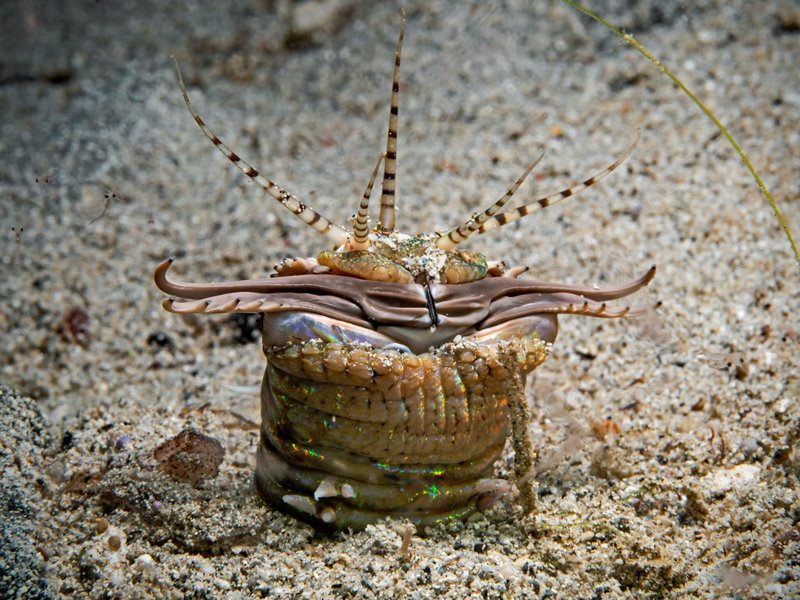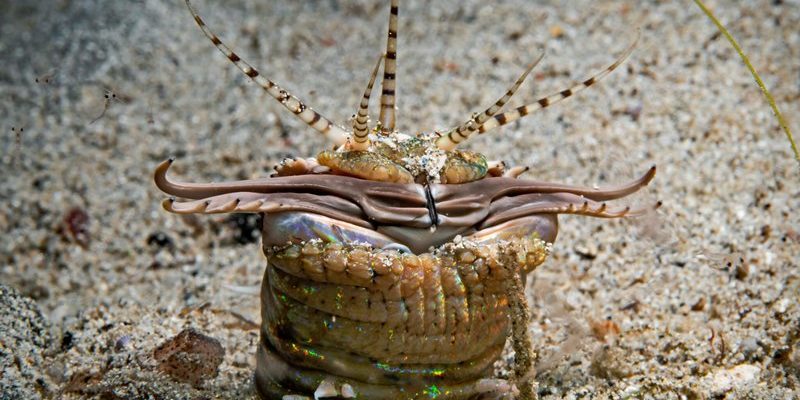
Recently, researchers have made exciting discoveries about how bobbit worms interact with their environment and prey. They’ve uncovered some intriguing aspects of their behavior that shed light on their hunting techniques, social interactions, and overall biology. Think of it like piecing together a puzzle; each new finding adds another layer to our understanding of these incredible animals. So, let’s dive deeper into what makes bobbit worms so unique!
What Are Bobbit Worms?
Bobbit worms, scientifically known as *Eunice aphroditois*, are large marine polychaetes that can grow up to 10 feet long! They inhabit tropical and subtropical waters, often burrowing into the ocean floor or coral reefs. Their bodies are segmented and extend into a vibrant array of colors, ranging from deep greens to bright reds. At a glance, you might mistake them for just another type of worm, but there’s much more beneath the surface.
These worms have a rather dramatic hunting style. They remain hidden in their burrows, extending only their heads, which sport a range of sensory organs. This camouflaged approach allows them to ambush prey, including fish and crustaceans, as they swim by. Imagine waiting silently in a game of hide-and-seek, ready to pounce at just the right moment—that’s how a bobbit worm hunts!
What’s also fascinating is their reproductive behavior. Bobbit worms can reproduce through both sexual and asexual means. In some cases, they can even regenerate body parts if they become injured. This regenerative ability makes them not only resilient but also a subject of interest for scientists studying regeneration and healing.
Recent Discoveries in Bobbit Worm Behavior
In recent months, researchers have focused on understanding the social dynamics of bobbit worms, particularly regarding their territorial behaviors. It turns out that these worms are far more social than we ever imagined. They have been observed engaging in complex interactions with each other, including displays of aggression when competing for territory. Some studies suggest that these interactions may help establish dominance hierarchies among individuals, which is crucial for survival in crowded habitats.
Moreover, scientists have discovered that bobbit worms exhibit a variety of responses to environmental changes. For instance, they react to different light conditions and vibrations in the water. This sensitivity not only helps them avoid predators but also enhances their hunting efficiency. Imagine having a built-in radar system that alerts you to potential threats or opportunities—that’s how these worms operate!
In addition, recent research indicates that bobbit worms can communicate through chemical signals in their environment. This “chemical language” helps them find mates and navigate their territory more effectively. It’s like having a secret code that only they understand, making their interactions in the underwater realm even more intriguing.
The Bobbit Worm Hunting Technique
One of the most spectacular aspects of bobbit worm behavior is their incredible hunting technique. When prey approaches, the bobbit worm strikes with lightning speed. Some studies have shown that they can extend their jaws up to 1.5 times their body length in just milliseconds! Their sharp, serrated jaws are designed to grasp and immobilize prey quickly.
Here’s the thing: this hunting strategy is not just about speed; it’s also about precision. Bobbit worms can assess the size and type of prey based on vibrations in the water. This skill allows them to target the most suitable meals, ensuring they get the nutrients they need to thrive.
Additionally, bobbit worms have been seen using a method called “sit-and-wait predation.” This involves staying perfectly still while waiting for prey to come within striking distance. By blending into their environment, they become almost invisible, making it easy for unsuspecting fish to swim right into their trap. It’s a clever strategy—like using a well-hidden fishing line to catch your dinner!
Environmental Impact on Bobbit Worm Behavior
The environment plays a significant role in shaping bobbit worm behavior. Recent studies indicate that changes in water temperature and salinity can greatly affect their hunting success and reproductive patterns. For instance, during warmer months, bobbit worms become more active, leading to increased hunting and mating activities.
Changes in habitat due to climate change or human activities, like pollution or coastal development, can also impact their behavior. Bobbit worms depend on healthy coral reefs for shelter and food. If these ecosystems deteriorate, it could lead to a decline in their populations.
Moreover, researchers are investigating how bobbit worms adapt to various environmental stresses. Their ability to tolerate fluctuations in ocean conditions may provide insights into the resilience of other marine species facing similar challenges. It’s like studying a canary in a coal mine; bobbit worms can help scientists understand the health of marine ecosystems overall.
Bobbit Worms and Human Interaction
As intriguing as these creatures are, bobbit worms also remind us of the delicate balance within marine ecosystems and human interactions with nature. The fascination with their behavior has driven efforts to study and protect these fascinating animals. You might be wondering how we can contribute to their conservation.
One way to help is by supporting sustainable fishing practices and reef restoration projects. When we take care of our oceans, we ensure a healthier habitat for bobbit worms and countless other marine species. Every small action counts, whether it’s participating in beach cleanups or advocating for policies that protect marine environments.
Additionally, researchers are leveraging technology to study these worms in their natural habitats. Underwater cameras and sensors allow scientists to observe and record bobbit worm behavior without disturbing them. This non-invasive approach is crucial for gaining insights while minimizing human impact on their ecosystems.
The Significance of Studying Bobbit Worm Behavior
Understanding bobbit worm behavior isn’t just about curiosity; it has broader implications for marine biology and ecology. These discoveries help scientists develop models for ecosystem dynamics, predator-prey relationships, and species interactions. By unraveling the mysteries of bobbit worms, researchers can better comprehend the complexities of underwater life.
Furthermore, insights gained from studying bobbit worms may even inspire innovations in biomimicry. Their hunting techniques and sensory adaptations could inform the design of new technologies or approaches in various fields, from robotics to environmental monitoring. It’s fascinating to think how nature’s clever solutions can influence human ingenuity!
In conclusion, the latest discoveries about bobbit worm behavior paint a vivid picture of these extraordinary marine creatures. From their unique hunting techniques to their interactions with the environment, bobbit worms continue to reveal astonishing insights that deepen our appreciation for the marine world. Let’s cherish these wonders and work together to safeguard their habitats for future generations.

